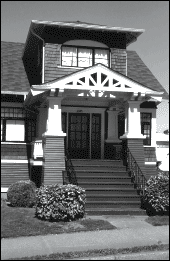
This style was a sub-set of the broader Arts & Crafts movement that was divided into two distinct streams of influence. The first of these was the British Arts & Crafts, inspired by the earlier Arts & Crafts movement in Britain. The second was the American Arts & Crafts, based heavily on rural and vernacular styles in Britain and Japan as well as Switzerland.
The Craftsman style was more closely related to the American Arts & Crafts, which matured on the West Coast, particularly in California, and represented a rejection of the classical inspiration of the Edwardian. The British Arts & Crafts style tended to be heavier in appearance, with freer massing and restrained decoration.
What to look for….

Common Elements
- asymmetrical plans
- multiple gable end roofs and dormers
- stucco, shingles, clinker brick, granite, smooth wood trim, and other natural materials
- rich contrasts in textures and materials American Elements
- expansive low pitched, gable roofs with deep overhanging eaves
- exposed structural elements, such as rafter tails, beams and brackets
- Orientalized California bungalow derived from this style
British Elements
- some half-timbering carried over from the Tudor style
- bungalows based on this style were typically taller and came later in Vancouver and Victoria
- roughcast stucco used as the main wall cladding


